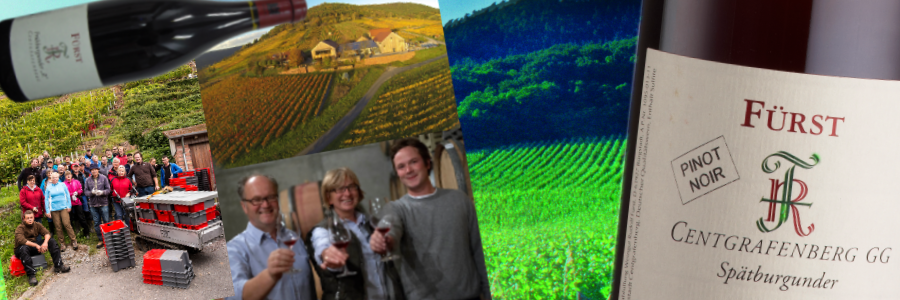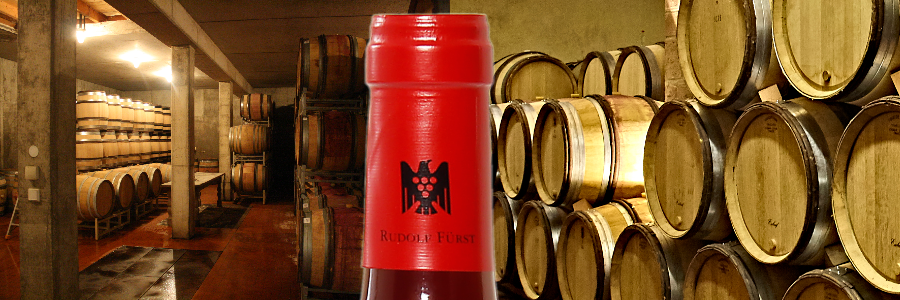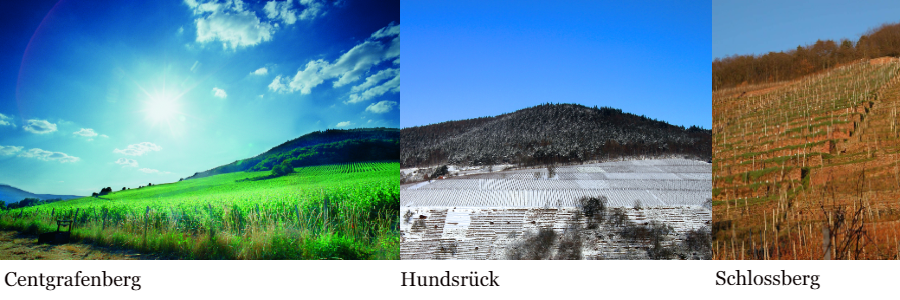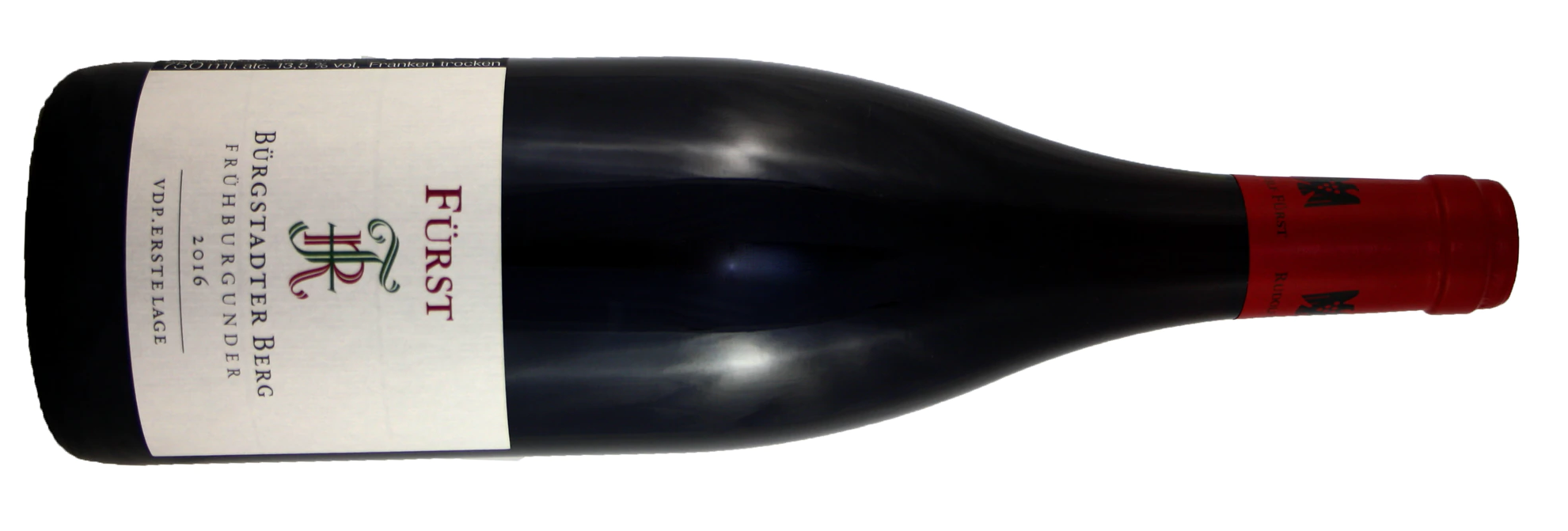If you like a long, informative, up-to-the-minute read, this blog's for you...
If you really like PINOT NOIR, this one's definitely for you!

Above photo - Paul & Monika with their son, Sebastian - Vineyards, winery & the team
The idea of trying to taste wines, listen to the winemaker and make notes (all at the same time) via a Zoom meeting is definitely hard work; thirsty work, you might say.
The chance to sample some of Germany’s (and the world’s) greatest examples of Pinot Noir (Spätburgunder) from the, as yet, unreleased 2018 vintage, was an opportunity not to be missed.
Sebastian, who took over from his father, Paul, in 2007, was leading the online tasting and gave a rundown of the 3 latest years’ vintage conditions:
2020 - A hot year that is expected to commence picking of early-ripening varieties in the first week of September (much earlier than normal). Most of Franken had lots of frost, but there was none in the vineyards owned by Weingut Rudolf Fürst. Everything is harvested by hand and, surprisingly, their pickers are mainly locals; 60% have been coming for 20 years, or more!
2019 – Even hotter, but also very dry conditions.
2018 – The hottest ever year on record with zero frosts. Very healthy grapes were harvested in around a week in ideal conditions; unusually, the ripening/picking time the same as in Burgundy. Normally, Bürgstadt is 10 days behind in their harvest date. So, what will the wines be like to taste?
The Fürst family’s involvement in winemaking originally began nearly 400 years’ ago in the Bavarian town of Bürgstadt, close to the River Main, in the north-west corner of Franconia. A long way from the major white wine producing areas of the Rhine and Mosel, this more southerly region was also known for making mostly dry whites using grape varieties such as Silvaner, Weißburgunder (Pinot Blanc) and Riesling. Certain warmer parts were suitable for red varieties and the local, early ripening Frühburgunder (part of the Pinot family) was established in the vineyards surrounding Bürgstadt, along with an increasing planting of the classic grape of Burgundy, Pinot Noir.
35 years’ ago, Pinot Noir clones were allowed to be sourced from outside Germany and Paul & Sebastian took advantage of this to plant the favoured, better quality Burgundian Dijon 777 and 828.
High density planting (to encourage the vines to work hard for the nutrients in the soil) and low yields of quality grapes suit the Fürst’s desire for making supreme examples of Pinot Noir.

The wines are all aged in small French oak barrels for between 12-20 months and are bottled unfiltered. It’s all about retaining as much flavour as possible.
The vineyard soils of the area are poor and shallow, but iron-rich from the red, sandstone bedrock and the red wines produced here have a real savoury character to them.
The top sites (Grosse Lage) near Bürgstadt are Centgrafenberg, Hundsrück and the tiny, steep, terraced vineyard of Schlossberg in the village of Klingenberg.
 Today’s tasting
offering consisted of one, village-level Chardonnay
(favoured as a grape variety by Sebastian with his earlier connection to the superb
Meursault wines of Domaine Roulot), an Erste
Lage (Premier Cru) red wine made using Frühburgunder
and three Pinot Noir from
different quality vineyards (ranging from their top-selling, blended
“Tradition”, followed by a single vineyard wine from Bürgstadt, and a Grosses Gewächs (the VDP producers’ association equivalent
to a French, Burgundy Grand Cru) from
Centgrafenberg.
Today’s tasting
offering consisted of one, village-level Chardonnay
(favoured as a grape variety by Sebastian with his earlier connection to the superb
Meursault wines of Domaine Roulot), an Erste
Lage (Premier Cru) red wine made using Frühburgunder
and three Pinot Noir from
different quality vineyards (ranging from their top-selling, blended
“Tradition”, followed by a single vineyard wine from Bürgstadt, and a Grosses Gewächs (the VDP producers’ association equivalent
to a French, Burgundy Grand Cru) from
Centgrafenberg.
The final wine on the tasting was an older vintage (2013) from the same Grand Cru. Samples were taken from the very last library bottle in the UK!
Fürst’s other two Grosses Gewächse; one at Hundsrück (currently an eye-watering £150 a bottle) and the other at Schlossberg in Klingenberg (a mere £100 a bottle), were, unfortunately, not available to try. A pity, as the Hundsrück scores (95-96) and the Schlossberg (95-97) in the Wine Advocate. These are EXTRAORDINARY wines!
So, at last, the bottles, themselves:
1/ Fürst Astheimer Karthäuser Chardonnay, 2018
This vineyard is located next to the famous Silvaner site at Escherndof Lump (I love these names!).
Chardonnay, first planted on the stony, rocky, limestone soils back in 1997, is now used to make three different wines making up 12-15% of the winery’s production.
Technical: The village-level wine on taste here has fruit sourced from 10-15 year old vines cropping at 30-40hl/ha. The grapes first undergo a light crushing, then pressing direct to oak barrels (10% new) for primary fermentation. The wine is then put through a natural malolactic fermentation. After 12 months in barrel the wine is returned to steel tanks for further ageing on its lees before bottling.
And my tasting note, you ask?
Flavours of apple and butter. Good acidity. Rich texture. Finishes dry with a note of fresh peach.
Definitely Chardonnay!
2/ Fürst Spätburgunder “Tradition”, 2018
Lots of technical stuff: The mainstay of the range with 15-20,000 bottles produced each year. Blended from various plots of Pinot Noir grapes grown on red sandstone soils around Bürgstadt. A combination of fruit from 45 year vines and the young vines from the Erste Lage and Grosses Gewächs sites. A third is based on Burgundian clones, two thirds on German clones. Sebastian is looking to increase the planting of vines sourced from the French clones.
Even though 2018 was very hot, the yield increased from the normal 40hl/ha to 50hl/ha (still low, by the standards of many growers).
Fermentation took place in open top vats with a 5-7 day maceration at 10°C - 12°C. One week of pumpovers followed by punching down of the cap. After 17-21 days, the must was run through a basket press and put into 228L barrels (Using used, 2-10 year old casks, no new oak). Ageing for one year in oak before bottling unfiltered.
My tasting note: Earthy aroma, lots of tannin on the palate, finishes with a blackberry note and a slightly syrupy texture. Still very young. Needs time.
The Wine Advocate just happens to rate Fürst’s 2018 an amazing 91/100 points. Pretty good for their entry level wine. Most winemakers would only get that for their best wine.
Frazier’s currently stock the slightly more mature, 2016 vintage of the “Tradition” at £26.50/bt

3/ Fürst Bürgstadter Berg Frühburgunder, 2018
Firstly, a bit about the grape, Früburgunder. A mutated form of Pinot Noir, planted for centuries in the coolest areas of Bürgstadt, Franken, it’s also known as Pinot Precoce and crops up quite often in England’s vineyards (including Sharpham, in Devon). It’s an earlier ripening (2 weeks before Pinot Noir), naturally low-yielding variety (up to 25hl/ha) that is very thin skinned and often suffers damage and crop loss. Birds and wild boar love eating it. Don’t ask… I don’t have a “pecking” order of varieties!
The Erste Lage rated Berg vineyard is next to the winery and, in 2018, there were no rotten berries, so, all good here as far as the grapes needed to make the wine.
The 2020 harvest of “Fruh” grapes is likely to begin in the first week of September.
Fürst also have a “Reserve” Früburgunder wine with fruit sourced from their Centgrafenberg GG vineyard.
My tasting note: Noticeable smoky oak character on the nose. More palate weight than the “Tradition” and an improvement with aeration in the glass. Red fruits with a lovely strawberry finish.
Frazier’s have the 2016 vintage available for £39.50/bt
 Buy some here SOLD OUT
Buy some here SOLD OUT
4/ Fürst Bürgstadter Berg Spätburgunder, 2018
Technical: Also from Berg vineyard, this time it’s the Spätburgunder (Pinot Noir) variety. A hot vintage, the crop was all harvested by the end of August. That’s early!
This wine also contains some extra, high-quality fruit taken from the Grosses Gewächse Hundsrück and Centgrafenberg vineyards. Just a little touch of the good stuff.
Due to the ripeness of the vintage, 60% of the fruit is fermented as whole clusters (includes stalks/stems). This tends to add a leaner, more earthy character to a wine. Some people love this, some don’t. The joy of Pinot Noir. You could write a book about it!
Current vintages in the UK sell for around £35-£40 a bottle. We’re getting serious.
My tasting note: A light feel with plenty of acidity. Toasty (25% new oak). A powerful wine, but I thought the fruit was hidden. It’s more earthy than fruity at present. You’ll want to age this for at least 5 years before drinking.
Wine Advocate rating: (92-93) /100 - Moving up the charts to #5…
5/ Fürst Centgrafenberg Spätburgunder Grosses Gewächs, 2018
You’ll need a serious bank balance now, as we reach the ‘Grand Cru’ level (GG) of quality. Wines in the UK are on the market for £70-£90 a bottle each, so, start saving for when the 2018s are released. Who needs a new car, anyway? Invest, instead, in some great wine.

Technical: The 11ha Centgrafenberg vineyard is the longest family-owned plot. Here, you’ll find some of the most highly prized vines, of which, 90% of the Pinot Noir are from Burgundy clones. There are 20 separate plots within the vineyard; both red and white varieties are planted here.
100% of the Spätburgunder fruit is fermented using whole bunches. The wine is given the usual French oak ageing with no filtration. It’s all in the bottle and it’ll need years of maturation to show its true elegance. You just need to be patient with this one!
My tasting note: More fruit aroma than the single vineyard Berg wine. It’s softer on the palate with a long, savoury finish. Spicy oak dominates at the moment. This is a very young wine of excellent quality.
Wine Advocate rating: (94-95)/100 – At the top end of OUTSTANDING
6/ Fürst Centgrafenberg Spätburgunder Grosses Gewächs, 2013
The final wine of the afternoon’s tasting was a mature example from a cool vintage, but it was truly stunning!
Technical: 2013 wasn’t an easy vintage. There were very low yields from the vines. No frost or hail problems, but the growing season was cool and rainy, with picking being delayed into October. More berry selection was needed and, due to the coolness of the weather, only 30%-40% of the fruit was fermented using whole cluster. The rest was destemmed.
My tasting note: Mushroom aroma. Elegant structure and acidity. Red fruits dominating rather than oak. Herbal, savoury notes on the palate. Very long, silky finish. Very good!
In fact, I liked this wine so much that I scoured the internet for some and even asked the supplier if they had another “last bottle” somewhere, but no luck at all. *!$£* ! I really wanted a bottle.
Perhaps I’ll start saving for a 2018 Schlossberg or Hundsrück?
Anyone got a spare £900? They’re only being sold in sixes!!!

